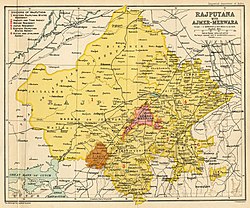
The Rajputana Agency was a political office of the British Indian Empire dealing with a collection of native states in Rajputana, under the political charge of an Agent reporting directly to the Governor-General of India and residing at Mount Abu in the Aravalli Range. The total area of the states falling within the Rajputana Agency was 127,541 square miles (330,330 km2), with eighteen states and two estates or chiefships.

Jodhpur is the second-largest city of the north-western Indian state of Rajasthan after its capital Jaipur. As of 2011, the city has a population of 1.03 million. It serves as the administrative headquarters of the Jodhpur district and Jodhpur division. It is historic capital of the Kingdom of Marwar, founded in 1459 by Rao Jodha, a Rajput chief of the Rathore clan. On 11 August 1947 four days prior to the Indian independence, Maharaja Hanwant Singh, the last ruler of Jodhpur state signed the Instrument of Accession and merged his state in Union of India. On 30 March 1949, it became part of the newly formed state of Rajasthan, which was created after merging the states of the erstwhile Rajputana Agency.

Marwar is a region of western Rajasthan state in North Western India. It lies partly in the Thar Desert. The word 'maru' is Sanskrit for desert. In Rajasthani languages, "wad" means a protected area. English translation of the word 'marwar' is the region protected by desert.

Chauhan, a name derived from the historical Chahamanas, a clan name associated with various ruling Rajput families in the present-day Indian state of Rajasthan from seventh century onwards.
Gorwar or Godwar, is a region of Rajasthan state in India, which lies in the southwest Rajasthan and borders with the state of Gujarat.
Jalore, also known as Granite City, is a city in the western Indian state of Rajasthan. It is the administrative headquarters of Jalore District.

Rao Maldeo Rathore was a king of the Rathore dynasty, who ruled the kingdom of Marwar in present day state of Rajasthan. Maldeo ascended the throne in 1531 CE, inheriting a small ancestral principality of Rathore's but after a long period of military actions against his neighbours, Maldeo swept significant territories which included parts of present day Rajasthan, Haryana, Uttar Pradesh, Gujarat and Sindh. He refused to ally with either the Sur Empire or the Mughal Empire.

Rao JodhaRathore was the 15th Rajput chief of Rathore clan who ruled the Kingdom of Marwar in the present-day state of Rajasthan. He was the eldest son of Rao Ranmal. He is known for his illustrious military career and for founding the city of Jodhpur in 1459, which subsequently became the new capital of Marwar after Mandore.

Gaurishankar Hirachand Ojha, born in Rohida village of Sirohi District, was a historian from the Indian state of Rajasthan. A prolific author, he wrote several books on the history of Rajasthan and other historical subjects. Subsequent historians from Rajasthan have referred to him as Guruvara Mahamahopadhyaya. Ojha regarded Kaviraj Shyamaldas as his guru and worked under him as assistant secretary of the historical department, Udaipur

Rājputana, meaning Land of the Rajputs, was a region in the Indian subcontinent that included mainly the present-day Indian state of Rajasthan, as well as parts of Madhya Pradesh and Gujarat, and some adjoining areas of Sindh in modern-day southern Pakistan.

The history of human settlement in the western Indian state of Rajasthan dates back to about 100,000 years ago. Around 5000 to 2000 BCE many regions of Rajasthan belonged as the site of the Indus Valley Civilization. Kalibangan is the main Indus site of Rajasthan, here fire altars have been discovered, similar to those found at Lothal.

The Kingdom of Mewar was an independent kingdom that existed in the Rajputana region of the Indian subcontinent and later became a major power in medieval India. The kingdom was initially founded and ruled by the Guhila dynasty followed by the Sisodiya Dynasty. The earliest kingdom was centered around the south-central part of Rajasthan, state of India. It was bordered by the Aravali Range to the northwest, Ajmer to the north, Gujarat, Vagad and Malwa regions to the south and the Hadoti region to the east.

Kingdom of Marwar, also known as the Jodhpur State under the British, was a kingdom in the Marwar region from 1243 to 1818 and a princely state under British rule from 1818 to 1947. It was established in Pali by Rao Siha, possibly a migrant Gahadavala noble, in 1243. His successors continued to struggle against regional powers for domination and 9 out of 15 rulers till 1438 died in combat. In 1395, its capital was changed to Mandore by Rao Chunda of Mandore and to Jodhpur in 1459 by Rao Jodha.

Dursa Arha was a 16th-century warrior and Rajasthani (Dingal) poet from India. He earned the epithet of the 'First Nationalist Poet Of India' or Rashtrakavi because of his nationalist stance in his bold Dingal poems commending Maharana Pratap of Mewar in his struggle against the Mughal Empire. He is one of the most highly regarded poets of the time, who was also a valuable and respectable part of the Mughal court. He was a renowned litterateur, historian, war general, consultant, administrator, feudal lord, and magistrate. He had close relations with the rulers of many erstwhile kingdoms. On the basis of wealth, fame, and honor Dursa Arha acquired in his lifetime and his contribution to medieval Indian history and literature, the historians and litterateurs consider him as one of the greatest poets. Dursa Arha attained heights of opulence and grandeur reached by no other poet in history.

Bikaner State was a princely state in the Rajputana from 1465 to 1947. The founder of the state, Rao Bika, was the eldest son of Rao Jodha, ruler of Jodhpur. Rao Bika chose to build his own kingdom instead of inheriting his father's. Bika defeated the Jat clans of Jangladesh along with his uncle Rao Kandhal and his adviser Vikramji Rajpurohit and founded his own kingdom. Its capital was the city of Bikaner in the northern area of present-day Rajasthan State in India. Karni Mata has been designated as the kuldevi of the royal family of Bikaner.
The Chahamanas of Jalor, also known as the Chauhans of Jalor in vernacular legends, were an Indian dynasty that ruled the area around Jalore in present-day Rajasthan between 1160 and 1311. They belonged to the Chahamana (Chauhan) clan of the Rajputs

Rao Ganga was the Rathore Rajput ruler of the Kingdom of Marwar. Rao Ganga ascended to the throne in the year 1515 through the support from his kinsmen and nobles. During his reign, the Rathores consolidated and expanded their rule in eastern Marwar.
Delwara, nestled in the Aravalli Range hills, is a small town about 28 km away from Udaipur, Mewar, and close to Eklingji Temple, on the way to the temple town of Nathdwara, in the state of Rajasthan, India. Delwara was originally known as ‘Devkul Patan Nagri’, which means the town of god. It boasted over 1500 temples at one time, out of which there were over 400 Jain temples. Delwara was the center of learning and culture before the 15th century AD. Around the middle of the 13th century, Raja Sagar, a Deora Chauhan and a descendant of Rao Kirtipal of Jalore, was a very brave king of Delwara (Mewar). Descendants of Raja Sagar sacrificed their lives while fighting alongside Ranas of Mewar against Muslim invaders. Raja Sagar was the progenitor of Bachhawat and Bothra clans of Oswals. Sagar's son, Kunwar Bohitya was immensely influenced and inspired by Jain philosophy. Samdhar, a grandson of Bohitya and a Deora Chauhan, was the first man in his genealogy to convert to Jainism.
Deora or Devda, Devra is a clan of Rajputs. The Deora dynasty historically ruled over Bhinmal, Sirohi and Chandravati, India. Rao Deoraj was the progenitor of the Deora clan.


















